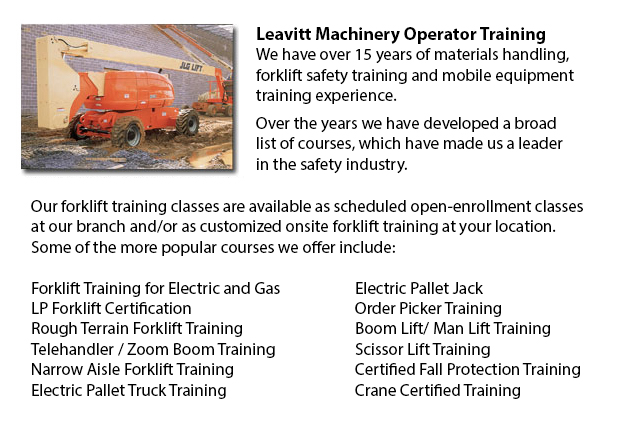
Toronto Manlift Training - There are numerous manlift training programs that provide a review of the manlift equipment. The practicum part of the training is one more vital part of the course. In this section the trainee has chance to show their practical abilities, their ability to operate the manlift safely. A prerequisite to Manlift training is the fall protection training, which may be included in the training according to the specific requirements of the client.
Course Content
The course content consists of: pre-shift machine inspection and work area survey requirements; the impact of performing unsafe acts or operating unsafe machines, Review of load capacities, Lifting devise machine definitions, the specific equipment requirements and safety decals, Review of related parts of the OSHA Standards as well as the CSA Standards and Review site specific Dangers, together with controls for safe operation of a lifting device.
Demonstration and Evaluation Content
The evaluation and demonstration portion of the program consists of: Utilizing a spotter or a signaler when required; Proper personal protective equipment or likewise referred to as P.P.E. as required; Utilizing a lift just on solid and level ground; Making use of a correct fitting harness or fall arrest device; Aware of load restrictions and all that. and other specs set out by the manufacturer; Operating the lift with all other workers clear of the job location; Having all associated equipment safely stored on the lift platform; Pre-shift work area survey and machine inspection; Isolating off the work place when major work projects are to be finished; and ensuring a safe and smooth operating speed for various plant conditions
Each individual will be tested to make certain they can efficiently and safely utilize your site-specific equipment.
Manlift Safety
As the manlift is capable of lifting personnel and materials over 20 feet in the air, these machines pose a particular amount of risk and can be dangerous equipment if not used properly. Since the danger is so apparent, lift operators and owners are careful to properly maintain their equipment and follow correct operating procedures and safety precautions. The ratio of accidents involving this specific machinery is rather low.
The safe operation of the boom lift, scissor lift and the manlift is up to the operator of that equipment. They have to know all of the responsibilities that go with running the equipment and how to operate the lift vehicle safely. The most basic safety features on the equipment are safety decals and the operating guidebook. These show vital information about the maintenance, operating procedures and safety equipment.
Newer lift models would come along with instruction manuals and decals in place. Technically, the operating handbook should be stored on the lift itself. If you are buying a used lift, it is important to ensure that the instruction manual is included and that important decals haven't been painted over. The restraints which prevent operators from falling and the guardrails are other vital safety features. These are mandatory and standard on all kinds of lifts.
-
Toronto Wheel Loader Training
Toronto Wheel Loader Training - Normally, the different kinds of heavy equipment training are classed into 2 categories of machinery: those that have rubber tires and tracked vehicles. Tracked vehicles consist of items like for example excavators, cr... More -
Toronto Heavy Equipment Operator Training
Toronto Heavy Equipment Operator Training - Heavy equipment operator training facilities that provide good standards in the business, providing field performance tasks and added machinery training are really sought after training features. Students a... More -
Toronto Manlift Operator Certification
Toronto Manlift Operator Certification - We provide an aerial lift and scissor platform certification and training to empower the trainee with the general understanding and knowledge of the safe and efficient use of "Power Operated Mobile Work Platfo... More -
Toronto Aerial Boom Lift Ticket
Toronto Aerial Boom Lift Ticket - Aerial lifts can be utilized to accomplish a lot of unique duties done in hard to reach aerial spaces. Some of the odd jobs associated with this type of jack include performing regular preservation on structures with... More -
Toronto Heavy Equipment License
Toronto Heavy Equipment License - Obtaining a heavy equipment license is mandatory in order to operate these big industrial machinery. Certification could be acquired through a vocational school or private training. The license would enable the drive... More -
Skid Steer Loader Training in Toronto
A skid-steer loader is an engine powered equipment which consists of a small and rigid frame. It is outfitted together with lift arms that are utilized to connect to a large variety of labor saving tools and attachments. Typically, skid-steer loaders... More -
Toronto Aerial Lift Certification
Toronto Aerial Lift Certification - Aerial Lift Certification is for individuals who requires an in-depth understanding of aerial lift safety. Inspectors and operators, supervisors, maintenance workers and construction craftsmen should perform a cert... More -
Toronto Boom Lift Training
Toronto Boom Lift Training - Elevated work platforms, also called aerial platforms, allow workers to carry out tasks at heights which would otherwise be not reachable. There are different kinds of lifts intended for various site conditions and applic... More

Forklift Certification Toronto
TOLL FREE: 1-888-254-6157
Toronto, Ontario
forkliftcertificationtoronto.com
Email Us
About Us


